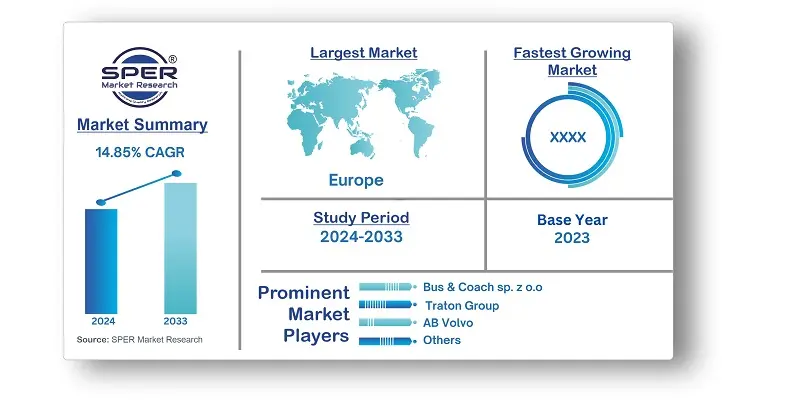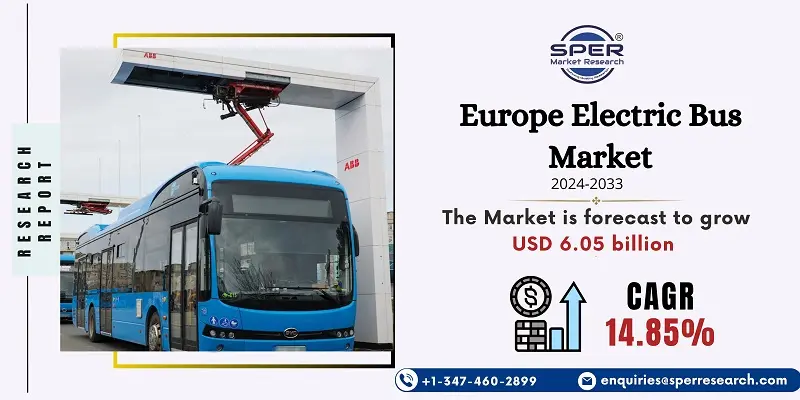
Europe Electric Bus Market Growth, Size, Trends, Demand, Share, Revenue and Future Outlook
Europe Electric Bus Market Size- By Propulsion Type, By Battery Type, By Consumer Type- Regional Outlook, Competitive Strategies and Segment Forecast to 2033
| Published: May-2024 | Report ID: AMIN24125 | Pages: 1 - 154 | Formats*: |
| Category : Automotive & Transportation | |||
- Van Hool unveiled the A-Series, a new line of zero-emission public buses, during the European Mobility Expo in Paris in June 2022. Fuel cell (hydrogen) and battery-electric drivetrain alternatives will be available for the A-series of zero-emission buses. In addition, there will be four distinct lengths (12, 13, 18, and 24 meters), with two to five passenger doors in each.
- At BUS2BUS in Berlin in April 2022, Switch Mobility unveiled their latest electric bus, the Metrocity. At the European Mobility Expo in Paris later in June 2022, the business unveiled its new 12-meter bus.
- The NFI Group Inc. (NFI) subsidiary Alexander Dennis Limited (ADL) declared in August 2021 that it had been chosen as a supplier for 20 zero-emission hydrogen double-deck buses by the Liverpool City Region Combined Authority as a result of a competitive tendering procedure.


| Report Metric | Details |
| Market size available for years | 2020-2033 |
| Base year considered | 2023 |
| Forecast period | 2024-2033 |
| Segments covered | By Propulsion Type, By Battery Type, By Consumer Type |
| Regions covered | UK, France, Germany, Italy, Spain, Rest of Europe |
| Companies Covered | Bus & Coach sp. z o.o., Traton Group, Mercedes-Benz Group AG, IVECO Group, AB Volvo, EBUSCO, VDL Bus & Coach BV, BYD Auto Co. Ltd, Otokar Otomotiv Ve Savunma Sanayi AS, and Van Hool |
- Transit Agencies and Municipalities
- Government Authorities and Regulatory Bodies
- Investors and Financial Institutions
- Electric Vehicle Manufacturers
- Charging Infrastructure Providers
- Environmental Organizations and Advocacy Groups
| By Propulsion Type: |
|
| By Battery Type: |
|
| By Consumer Type: |
|
- Europe Electric Bus Market Size (FY’2024-FY’2033)
- Overview of Europe Electric Bus Market
- Segmentation of Europe Electric Bus Market By Propulsion Type (Battery Electric bus, Plug-in Hybrid Electric Bus, Fuel Cell Electric Bus)
- Segmentation of Europe Electric Bus Market By Battery Type (Lithium-ion, Nickel-Metal Hydride Battery, Others)
- Segmentation of Europe Electric Bus Market By Consumer Type (Government, Fleet Operators)
- Expansion Analysis of Europe Electric Bus Market
- Problems and Obstacles in Europe Electric Bus Market
- Competitive Landscape in the Europe Electric Bus Market
- Impact of COVID-19 and Demonetization on Europe Electric Bus Market
- Details on Current Investment in Europe Electric Bus Market
- Competitive Analysis of Europe Electric Bus Market
- Prominent Players in the Europe Electric Bus Market
- SWOT Analysis of Europe Electric Bus Market
- Europe Electric Bus Market Future Outlook and Projections (FY’2024-FY’2033)
- Recommendations from Analyst
1.1. Scope of the report1.2. Market segment analysis
2.1. Research data source2.1.1. Secondary Data2.1.2. Primary Data2.1.3. SPER’s internal database2.1.4. Premium insight from KOL’s2.2. Market size estimation2.2.1. Top-down and Bottom-up approach2.3. Data triangulation
4.1. Driver, Restraint, Opportunity and Challenges analysis4.1.1. Drivers4.1.2. Restraints4.1.3. Opportunities4.1.4. Challenges4.2. COVID-19 Impacts of the Europe Electric Bus Market
5.1. SWOT Analysis5.1.1. Strengths5.1.2. Weaknesses5.1.3. Opportunities5.1.4. Threats5.2. PESTEL Analysis5.2.1. Political Landscape5.2.2. Economic Landscape5.2.3. Social Landscape5.2.4. Technological Landscape5.2.5. Environmental Landscape5.2.6. Legal Landscape5.3. PORTER’s Five Forces5.3.1. Bargaining power of suppliers5.3.2. Bargaining power of buyers5.3.3. Threat of Substitute5.3.4. Threat of new entrant5.3.5. Competitive rivalry5.4. Heat Map Analysis
6.1. Europe Electric Bus Market Manufacturing Base Distribution, Sales Area, Product Type6.2. Mergers & Acquisitions, Partnerships, Product Launch, and Collaboration in Europe Electric Bus Market
7.1. Europe Electric Bus Market Size, Share and Forecast, By Propulsion Type, 2020-20267.2. Europe Electric Bus Market Size, Share and Forecast, By Propulsion Type, 2027-20337.3. Battery Electric bus7.4. Plug-in Hybrid Electric Bus7.5. Fuel Cell Electric Bus
8.1. Europe Electric Bus Market Size, Share and Forecast, By Battery Type, 2020-20268.2. Europe Electric Bus Market Size, Share and Forecast, By Battery Type, 2027-20338.3. Lithium-ion8.4. Nickel-Metal Hydride Battery (NiMH)8.5. Others
9.1. Europe Electric Bus Market Size, Share and Forecast, By Consumer Type, 2020-20269.2. Europe Electric Bus Market Size, Share and Forecast, By Consumer Type, 2027-20339.3. Government9.4. Fleet Operators
10.1. Europe Electric Bus Market Size and Market Share
11.1. Europe Electric Bus Market Size and Market Share By Region (2020-2026)11.2. Europe Electric Bus Market Size and Market Share By Region (2027-2033)11.3. France11.4. Germany11.5. Italy11.6. United Kingdom11.7. Rest of Europe
12.1. Bus & Coach sp. z o.o.12.1.1. Company details12.1.2. Financial outlook12.1.3. Product summary12.1.4. Recent developments12.2. Traton Group12.2.1. Company details12.2.2. Financial outlook12.2.3. Product summary12.2.4. Recent developments12.3. Mercedes-Benz Group AG12.3.1. Company details12.3.2. Financial outlook12.3.3. Product summary12.3.4. Recent developments12.4. IVECO Group12.4.1. Company details12.4.2. Financial outlook12.4.3. Product summary12.4.4. Recent developments12.5. AB Volvo12.5.1. Company details12.5.2. Financial outlook12.5.3. Product summary12.5.4. Recent developments12.6. EBUSCO12.6.1. Company details12.6.2. Financial outlook12.6.3. Product summary12.6.4. Recent developments12.7. VDL Bus & Coach BV12.7.1. Company details12.7.2. Financial outlook12.7.3. Product summary12.7.4. Recent developments12.8. BYD Auto Co. Ltd12.8.1. Company details12.8.2. Financial outlook12.8.3. Product summary12.8.4. Recent developments12.9. Otokar Otomotiv Ve Savunma Sanayi AS12.9.1. Company details12.9.2. Financial outlook12.9.3. Product summary12.9.4. Recent developments12.10. Van Hool12.10.1. Company details12.10.2. Financial outlook12.10.3. Product summary12.10.4. Recent developments12.11. Others
SPER Market Research’s methodology uses great emphasis on primary research to ensure that the market intelligence insights are up to date, reliable and accurate. Primary interviews are done with players involved in each phase of a supply chain to analyze the market forecasting. The secondary research method is used to help you fully understand how the future markets and the spending patterns look likes.
The report is based on in-depth qualitative and quantitative analysis of the Product Market. The quantitative analysis involves the application of various projection and sampling techniques. The qualitative analysis involves primary interviews, surveys, and vendor briefings. The data gathered as a result of these processes are validated through experts opinion. Our research methodology entails an ideal mixture of primary and secondary initiatives.



Frequently Asked Questions About This Report
PLACE AN ORDER
Year End Discount
Sample Report
Pre-Purchase Inquiry
NEED CUSTOMIZATION?
Request CustomizationCALL OR EMAIL US
100% Secure Payment






Related Reports
Our Global Clients
Our data-driven insights have influenced the strategy of 200+ reputed companies across the globe.




















